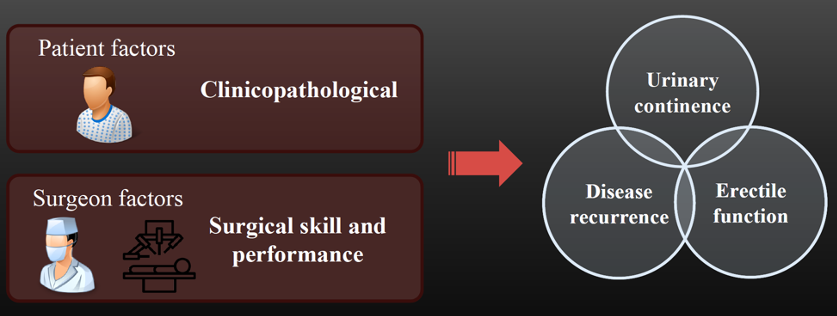AUA 2020: Automated Performance Metrics to Predict Continence Recovery After Robotic Radical Prostatectomy ... - UroToday
Automated performance metrics and clinicopathological data were collected for robot-assisted radical prostatectomies performed at three high-volume robotic centers:

The robot-assisted radical prostatectomy was segmented into 12 steps, and for each step, 41 validated automated performance metrics were reported. The predictive models were trained with three data sets: 1) 492 automated performance metrics; 2) 16 clinicopathological data (for example prostate volume, Gleason score); 3) automated performance metrics plus clinicopathological data. The authors utilized a random forest model (800 trees) to predict continence recovery (no pads or one safety pad) at three and six months after surgery. The prediction accuracy was estimated through a 10-fold cross-validation process. The area under the curve (AUC) and standard error (SE) was used to estimate prediction accuracy. Finally, the out-of-bag Gini index was used to rank the variables of importance.
There were 193 robot-assisted radical prostatectomies from three institutions that were included. Collectively, the median patient age was 65 years (range 49-83 years), median prostate-specific antigen (PSA) was 7.3 ng/mL (range 0.53-96 ng/mL), and median pathologic Gleason score was 7 (range 6 - 10). There were 21 attending surgeons included in this study, and the median robot-assisted radical prostatectomy experience of these surgeons was 478 cases (range 117-4970 cases). The median continence recovery time for the entire cohort was 94 days (range 16-553 days). At three months from surgery, 56.7% of patients achieved urinary continence, which improved to 73.3% at six months from surgery. Clinicopathological data alone produced an AUC 0.67 SE 0.04 for three-month prediction, while six-month prediction decreased to 0.63 SE 0.06. Automated performance metrics alone produced an AUC 0.72 SE 0.04 for three months, while six-month prediction was 0.64 SE 0.05. Finally, the combined automated performance metrics plus clinicopathological data dataset produced the same accuracy as automated performance metrics alone for both three months (AUC 0.73 SE 0.04) and six months (AUC 0.64 SE 0.05). In the top 10 ranked important features to predict three-month continence, automated performance metrics for certain steps were highlighted, including apical dissection (5/10 top features) and right pedicle dissection (3/10). Feature ranking for six-month continence again revealed automated performance metrics during apical dissection as important predictors (5/10). Notably, no patient factors were in the top 50 for either three- or six-month continence, as there was minimal confounding effect of age, body mass index (BMI), PSA, and prostate weight.
Dr. Hung concluded his presentation with the following take-home points:
- In this multi-institution study, automated performance metrics (surgeon factors) appear to be stronger predictors of continence recovery than patient factors (clinicopathological data) for men undergoing robot-assisted radical prostatectomy
- Metrics during the apical dissection and pedicle dissection appear to be important in determining continence recovery
Presented by: Andrew Hung, MD, Assistant Professor of Clinical Urology, Keck School of Medicine, University of Southern California, Los Angeles, California
Co-Authors: Runzhuo Ma, Steven Cen, Jessica Nguyen, Ryan Hakim, Swetha Rajkumar, Katarina Urbanova, Joern Witt, Inderbir Gill, Brian Miles, Christian Wagner
Written by: Zachary Klaassen, MD, MSc, Assistant Professor of Urology, Georgia Cancer Center, Augusta University/Medical College of Georgia, Augusta, Georgia, Twitter: @zklaassen_md at the 2020 American Urological Association (AUA) Annual Meeting, Virtual Experience #AUA20, June 27- 28, 2020
References:
1. Hung, Andrew J., Jian Chen, Saum Ghodoussipour, Paul J. Oh, Zequn Liu, Jessica Nguyen, Sanjay Purushotham, Inderbir S. Gill, and Yan Liu. "A deep‐learning model using automated performance metrics and clinical features to predict urinary continence recovery after robot‐assisted radical prostatectomy." BJU international 124, no. 3 (2019): 487-495.
2. Hung, Andrew J., Jian Chen, Anthony Jarc, David Hatcher, Hooman Djaladat, and Inderbir S. Gill. "Development and validation of objective performance metrics for robot-assisted radical prostatectomy: a pilot study." The Journal of urology 199, no. 1 (2018): 296-304.



Comments
Post a Comment